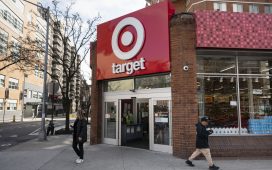It usually conjures images of Big Macs and fries, but drive-through dining is undergoing an upmarket makeover complete with sourdough sandwiches and street food as demand for meals on wheels accelerates in the UK.
The posh bakery chain Gail’s is the latest high-street brand to set its sights on roadside dining, putting its feelers out for 10 sites in south-east England where it can serve expensive bagels and brioches through car windows.
But it is not the only brand swapping high streets for A roads and roundabouts as the drive-through moves upmarket. The fast food chain Leon, which positions itself as a healthy option with its grilled halloumi wraps and baked fries, and the premium burger chain Five Guys have already taken the plunge.
The street food chain Chaiiwala recently opened the first Indian-themed one in Bolton, Greater Manchester, serving aloo tikka burgers and masala chips to drivers, and the noodle bar Chopstix has just got the go ahead for one at Markham Vale services in Derbyshire.
Analysts say there is now a race for space. Thomas Rose, a co-founder of the real estate consultancy P-Three, describes demand as “going crazy”, with brands looking for more than 300 sites a year. “There’s so much demand that supply can’t really keep up. There is a finite number of plots of land by a roundabout or busy bit of road, so we are seeing increased competition for locations and rents are going up.”
Drive-throughs have been around since the 80s when McDonald’s opened the first one in Fallowfield, Manchester, but have not had the same impact here as in America, not least given a desire to reduce car use and tackle obesity. They were enjoying a revival before the pandemic but this growth was turbocharged by strict Covid rules, with George Eustice, then enivronment minister, memorably describing them as “made for social distancing”.

Great Britain’s 2,256 drivethroughs took in just over £2.8bn in the year to the end of January, according to the market researchers NPD Group, albeit a figure down from the heights of the pandemic, when they raked in well over £3bn.
Attracting close to 500m visits a year to the drive-through is another quick way of getting food “where you don’t have to sit down and eat it with a knife and fork and a waiter hovering over you”, says Peter Backman, a restaurant industry consultant. They are part of a wider shift in food culture as younger consumers embrace new channels such as the home-delivery services offered by Deliveroo and Uber Eats.
“We’ve had drive-throughs for over 30 years and it has not really taken off except for a small number of brands,” Backman adds. “I’m a little bit sceptical because the reason it works in America is they’ve got the space and a very car-driven culture.”
The current clamour comes as the market leaders McDonald’s and KFC face competition from North American brands such as Tim Hortons, famous for its coffee and doughnuts, Wendy’s and Popeyes who are all on the expansion trail.
Drive-throughs save consumers time and businesses money, with sites able to double up as delivery hubs for nearby homes. Their appeal is the “sheer convenience” says Rose, with shift workers and parents with young children among their biggest fans.
“Operators like them because the costs are so much lower,” said Rose. “In the evenings you can operate on a skeleton staff and there’s no table clearing or cutlery to wash. You just push the food out the window. Typically the sales are very high because consumers love it.”

Gail’s has told property agents it is looking for “units of 2,000-4,000 sq ft in London and the home counties to cater for customers who are looking for great quality food whilst on the go”. It wants to nail down “at least 10 drive locations in the next 12 months”.
With the choice of geography, Gail’s is not straying far from the well-to-do high streets it usually calls home, but will this marriage of convenience work? “Obviously it does on paper,” says Backman. “But one of the attractions to me of going to Gail’s is being there and soaking up the atmosphere. A drive-through is just a transaction.”
after newsletter promotion
Higher-end food brands are following fast food outlets down this road because they know the formula works, says Backman. “The extent to which they are successful, remains to be seen. Do they sell enough? Does it damage the brand? Those are questions that people going into drive through will have to answer.”
A drive-through history
A staple of fast food culture in America, drive-through restaurants are becoming part of the furniture in the UK too amid a shift in spending that sees more Britons pull up for their morning coffee fix or a quick meal on the way home.
This type of restaurant made its world debut in 1947, when Red’s Giant Hamburg began flipping burgers on Route 66 in Springfield, Missouri. It had hit on a winning formula and today there are more than 200,000 drive-throughs across the US.
The concept did not cross the Atlantic until the 1980s, when McDonald’s opened the first in Manchester in 1986. One early customer, Chris Hammond, told the BBC on the site’s 30th anniversary that it seemed a “wacky idea” and his family were “suspicious” of the technology.
The model works best for food and drink that is easy to eat by hand so, after burgers and KFC nuggets, Britons were served up coffee and doughnuts courtesy of Starbucks, Costa Coffee and Krispy Kreme. More recently Greggs put sausage rolls on the car menu.
Today the number of drive-throughs in Great Britain has hit 2,256, according to the Local Data Company (LDC), after recording a net increase of 129 in the past year. The market leader, with 938, is McDonald’s, while second-placed KFC has 445. Behind them are Costa and Starbucks with 316 and 284.
“During the Covid pandemic, drive-throughs increased in popularity as a safer way of collecting food contact free,” says Ronald Nyakairu, head of insight and analytics at the LDC. “However, a few years on and we are still tracking year-on-year growth.
“These units are expensive to fit out for operators, and therefore are long-term investments, showing that this trend is not expected to slow any time soon with the race for space heating up across GB.”








